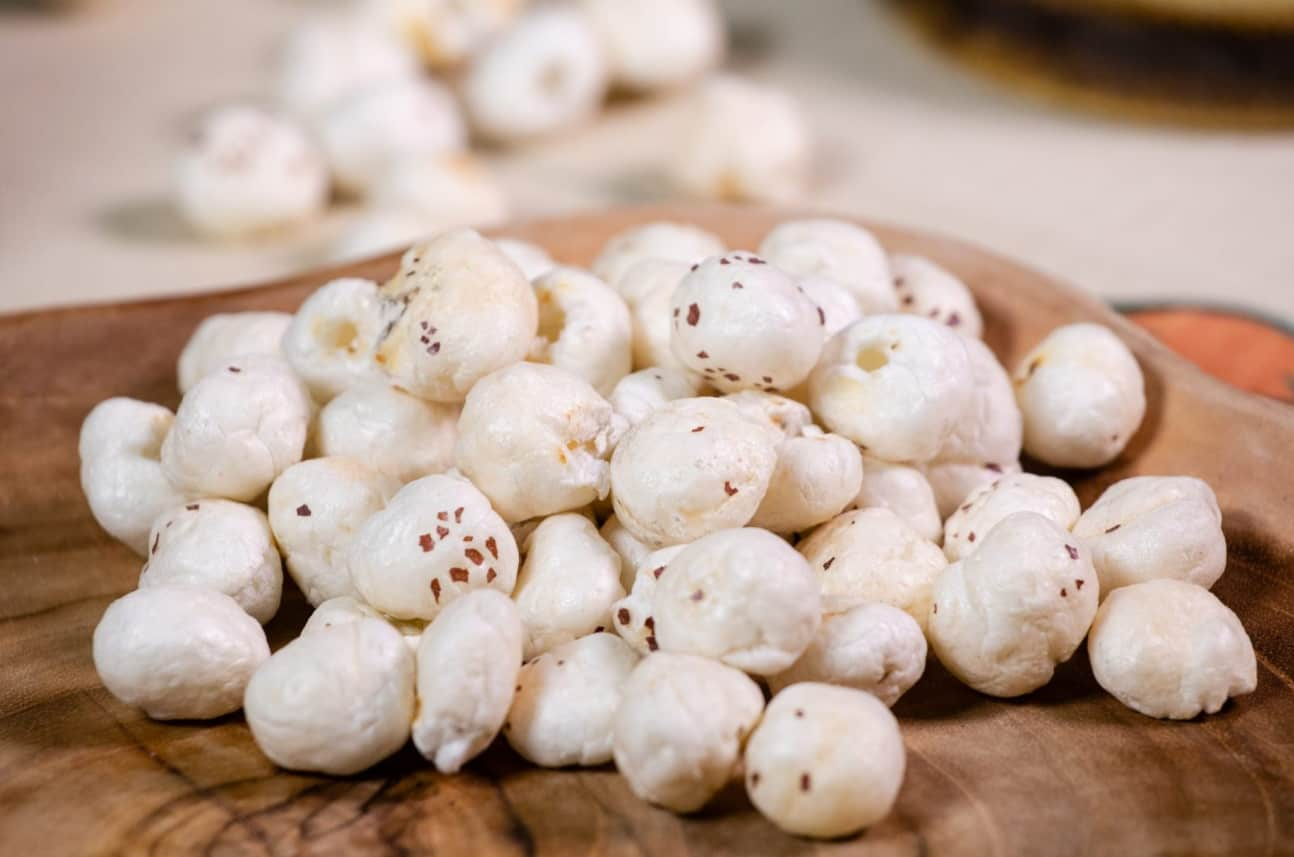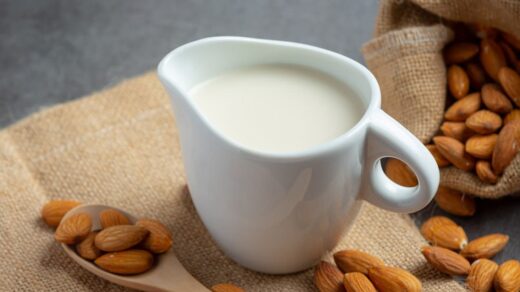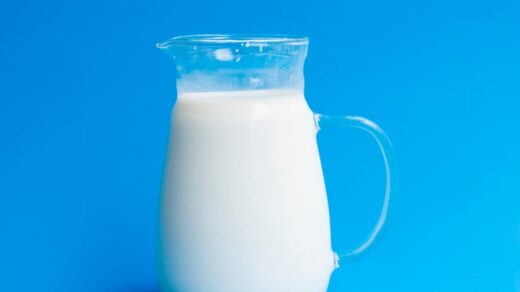Have you heard of Makhana? It’s a tasty snack that’s good for you too. Makhana, also known as fox nuts or lotus seeds, comes from a water plant.
People in Asia have eaten it for a long time. Now, more people around the world are trying it because it’s healthy.
Makhana looks like little white puffs. They’re light and crunchy. You can eat them plain or add flavors. Many people like to roast them with a bit of oil and salt. They’re easy to make and fun to eat.
In the past, only some countries knew about Makhana. But now, it’s getting popular everywhere. People who want to eat better are choosing Makhana as a snack.
It’s full of good things your body needs.
Makhana: The Nutrient-Packed Superfood

Let’s learn more about this little seed that’s making a big splash in the world of healthy foods!
Nutritional Profile of Makhana
Makhana is packed with good stuff for your body. Let’s break it down:
Macronutrients
- Protein: Makhana has a good amount of protein. This helps build and fix your muscles.
- Carbohydrates: It has some carbs, but not too many. These give you energy.
- Fat: There’s very little fat in Makhana. This is good if you’re watching your weight.
Micronutrients
Makhana is rich in vitamins and minerals:
- Magnesium: Good for your heart and muscles
- Potassium: Helps control blood pressure
- Phosphorus: Important for strong bones
- Calcium: Keeps your bones and teeth healthy
- Iron: Helps your blood carry oxygen
Calorie Content
100 grams of Makhana has about 347 calories. That’s not too high, which is good for a snack.
Comparison with Other Snacks
Let’s see how Makhana stacks up against other popular snacks:
| Snack (100g) | Calories | Protein (g) | Fat (g) | Carbs (g) |
|---|---|---|---|---|
| Makhana | 347 | 9.7 | 0.1 | 76.9 |
| Potato Chips | 536 | 7 | 35 | 53 |
| Peanuts | 567 | 26 | 49 | 16 |
| Popcorn | 387 | 13 | 4 | 78 |
As you can see, Makhana has fewer calories and less fat than many other snacks. It’s a healthier choice when you want something crunchy.
Health Benefits of Makhana
Makhana isn’t just tasty – it’s good for you too! Let’s look at how it can help your body:
Heart Health
Makhana can be great for your heart. Here’s why:
- Low Cholesterol: Makhana has no cholesterol. This is good because too much cholesterol can hurt your heart.
- Lots of Magnesium: Makhana has plenty of magnesium. This mineral helps your heart beat steadily and keeps your blood pressure normal.
- Fights Bad Stuff: Makhana has things called antioxidants. These fight harmful particles in your body that can damage your heart.
Diabetes Control
If you have diabetes or want to avoid it, Makhana can help:
- Slow Sugar Rise: When you eat Makhana, your blood sugar doesn’t go up fast. This is good for controlling diabetes.
- Lots of Fiber: Fiber slows down how fast your body takes in sugar. Makhana has plenty of fiber.
- Better than Sugary Snacks: Instead of eating sweets, you can munch on Makhana. It won’t make your blood sugar jump up.
Weight Management
Trying to keep a healthy weight? Makhana can be your friend:
- Few Calories: You can eat quite a bit of Makhana without getting too many calories.
- Feels Filling: The protein and fiber in Makhana make you feel full. This can stop you from eating too much.
Brain Health
Makhana is good for your brain too:
- Has Thiamine: This vitamin helps your brain work well.
- Helps Brain Signals: It may help your brain cells talk to each other better.
Kidney Health
Your kidneys might thank you for eating Makhana:
- Natural Helper: Makhana has stuff that might help prevent kidney problems.
- Fights Swelling: It may help reduce swelling in your body, which is good for your kidneys.
Makhana as a Convenient Snack
Makhana isn’t just healthy – it’s easy to eat too!
Easy to Make
You can make Makhana in just a few minutes:
- Put some Makhana in a pan.
- Add a little oil if you want.
- Heat and stir until they’re crispy.
- Add salt or spices if you like.
That’s it! Now you have a yummy snack.
Fits Many Diets
Makhana works for lots of different diets:
- It’s gluten-free for people who can’t eat wheat.
- It’s low in calories if you’re watching your weight.
- It’s often allowed during fasting in some cultures.
Great for Busy People
Makhana is perfect when you’re in a hurry:
- You can carry it anywhere in a small bag.
- It doesn’t make your hands messy like some snacks.
- You can eat it while working or studying.
Many Ways to Eat
You can enjoy Makhana in different ways:
- Plain: Just eat it as it is for a light snack.
- Roasted: Add spices for more flavor.
- In Dishes: Use it in kheer (a sweet dish) or curry.
Makhana in Different Cuisines
Makhana isn’t just a snack – it’s used in many dishes around the world!
Traditional Asian Uses
In some parts of Asia, people have eaten Makhana for a long time:
- India: It’s used in sweets and savory dishes.
- China: They put it in soups and teas.
Modern Cooking Ideas
Now, people are finding new ways to use Makhana:
- Makhana Trail Mix: Mix it with nuts and dried fruit.
- Makhana Curry: Use it instead of meat or paneer in curry.
- Makhana Pudding: Make a creamy dessert with it.
Popular Makhana Recipes
Here are some easy recipes you can try:
- Spicy Roasted Makhana
- Roast Makhana in a pan
- Add oil, salt, and chili powder
- Mix well and enjoy!
- Makhana Kheer
- Cook Makhana in milk until soft
- Add sugar and nuts
- Serve cold or hot
- Makhana Soup
- Boil Makhana with vegetables
- Blend and add cream
- Season and serve hot
Sustainability and Production of Makhana
Makhana isn’t just good for you – it’s good for the planet too!
How It’s Grown?
Makhana comes from a water plant:
- It grows in ponds and wetlands.
- Farmers pick the seeds when they’re ripe.
- They dry the seeds in the sun.
- Then they pop the seeds to make the puffy Makhana we eat.
Good for the Environment
Growing Makhana helps nature:
- It doesn’t need chemicals to grow.
- It keeps wetlands healthy.
- It uses less water than many crops.
Helps Farmers
Making Makhana is good for farmers:
- It gives them extra money.
- They can grow it in places where other crops don’t grow.
- It creates jobs in rural areas.
How to Choose and Store Makhana?
Picking good Makhana and keeping it fresh is easy!
Choosing Good Makhana
Look for these things:
- Color: Should be white or off-white.
- Size: All pieces should be about the same size.
- Texture: Should be hard and crisp, not soft or spongy.
Storing It Right
To keep Makhana fresh:
- Put it in an airtight container.
- Keep it in a cool, dry place.
- Don’t let water get in – it can make the Makhana soft.
How Long Does It Last?
- Unopened, Makhana can last up to a year.
- After opening, try to eat it within 2-3 months for the best taste.
Potential Side Effects and Precautions
While Makhana is generally safe, it’s good to know a few things:
Allergies
- Some people might be allergic to Makhana.
- If you get itchy or feel sick after eating it, stop and talk to a doctor.
Medicine Interactions
- Makhana is usually safe with medicine.
- But if you take medicine for diabetes, check with your doctor. Makhana might change your blood sugar.
Eating the Right Amount
- Makhana is healthy, but don’t eat too much.
- Like any food, too much can upset your stomach.
Makhana vs. Other Healthy Snacks
Let’s see how Makhana compares to other snacks people think are healthy:
Nutrition Comparison
| Snack (100g) | Calories | Protein (g) | Fiber (g) | Fat (g) |
|---|---|---|---|---|
| Makhana | 347 | 9.7 | 14.5 | 0.1 |
| Almonds | 579 | 21.2 | 12.5 | 49.9 |
| Greek Yogurt | 59 | 10 | 0 | 0.4 |
| Carrots | 41 | 0.9 | 2.8 | 0.2 |
Taste and Texture
- Makhana: Light and crunchy
- Almonds: Hard and crunchy
- Greek Yogurt: Creamy and smooth
- Carrots: Crunchy and juicy
How You Can Use Them?
- Makhana: Eat as is, roast, or add to dishes
- Almonds: Eat raw, roasted, or in baking
- Greek Yogurt: Eat plain, add fruit, or use in cooking
- Carrots: Eat raw, cook, or juice
Future of Makhana in the Health Food Industry
Makhana is becoming more popular around the world:
Growing Demand
- More people are learning about Makhana.
- Health food stores are starting to sell it.
- It’s becoming popular in countries where it wasn’t known before.
New Products
Companies are making new things with Makhana:
- Makhana flour for baking
- Makhana protein bars
- Flavored Makhana snacks
More Research
Scientists are studying Makhana more:
- They want to learn all its health benefits.
- They’re looking at how it can help with different health problems.
- This research might make Makhana even more popular.
Top 5 Natural Makhana Alternatives for Great Health Benefits to Use as Snack
Makhana, also known as fox nuts or lotus seeds, is a popular healthy snack. But what if you want to try something different? Here are five natural alternatives that are just as good for you and tasty too!
1. Roasted Chickpeas
Health Benefits:
- High in protein and fiber
- Good source of vitamins and minerals
- May help control blood sugar
Roasted chickpeas are crunchy and satisfying. They’re easy to make at home:
- Rinse canned chickpeas and pat dry
- Toss with a little oil and your favorite spices
- Roast in the oven until crispy
You can flavor them with salt, pepper, garlic powder, or even cinnamon for a sweet treat.
2. Almonds
Health Benefits:
- Rich in healthy fats
- Good source of vitamin E
- May lower cholesterol
Almonds are a classic healthy snack. They’re great plain, but you can also try:
- Roasting them with a little salt
- Mixing them with dried fruit for a quick trail mix
- Choosing flavored varieties like smoked or wasabi almonds
Remember, a small handful (about 23 almonds) is a good serving size.
3. Pumpkin Seeds
Health Benefits:
- High in magnesium and zinc
- Good source of antioxidants
- May improve heart health
Pumpkin seeds, also called pepitas, are small but mighty. They’re great as a snack because:
- You can eat them with or without the shell
- They’re easy to carry in a small container
- You can roast them with different seasonings
Try sprinkling them on salads or yogurt for extra crunch!
4. Air-popped Popcorn
Health Benefits:
- Low in calories
- High in fiber
- Contains antioxidants
Popcorn can be a healthy snack if you make it the right way:
- Use an air popper or a plain paper bag in the microwave
- Skip the butter and salt
- Try adding herbs or a sprinkle of nutritional yeast for flavor
Three cups of air-popped popcorn is a good serving size and only about 100 calories!
5. Roasted Edamame
Health Benefits:
- High in plant-based protein
- Good source of fiber
- Contains isoflavones, which may have health benefits
Edamame are young soybeans. They make a great snack when roasted:
- Buy frozen, shelled edamame
- Toss with a little oil and salt
- Roast in the oven until crispy
They have a nice crunch and a slightly nutty flavor.
Comparison Table
Here’s how these alternatives compare to Makhana:
| Snack (1 oz/28g) | Calories | Protein (g) | Fiber (g) | Fat (g) |
|---|---|---|---|---|
| Makhana | 97 | 2.7 | 4.1 | 0.03 |
| Roasted Chickpeas | 120 | 6 | 5 | 3 |
| Almonds | 164 | 6 | 3.5 | 14 |
| Pumpkin Seeds | 151 | 7 | 1.7 | 13 |
| Air-popped Popcorn | 31 | 1 | 1.2 | 0.4 |
| Roasted Edamame | 130 | 11 | 4 | 4 |
Conclusion:
Makhana is a great snack that’s good for you too. It’s full of nutrients and can help your heart, control diabetes, and manage weight. It’s easy to eat and fits into many diets.
Remember, Makhana is just one part of eating healthy. It’s good to eat different foods to get all the nutrients you need.
If you have health issues, always check with a doctor before changing what you eat.
Makhana shows us that healthy food can be tasty too. Whether you munch on it plain, add it to trail mix, or use it in cooking, Makhana is a smart choice for a snack.
Why not give it a try? You might find a new favorite healthy treat!



